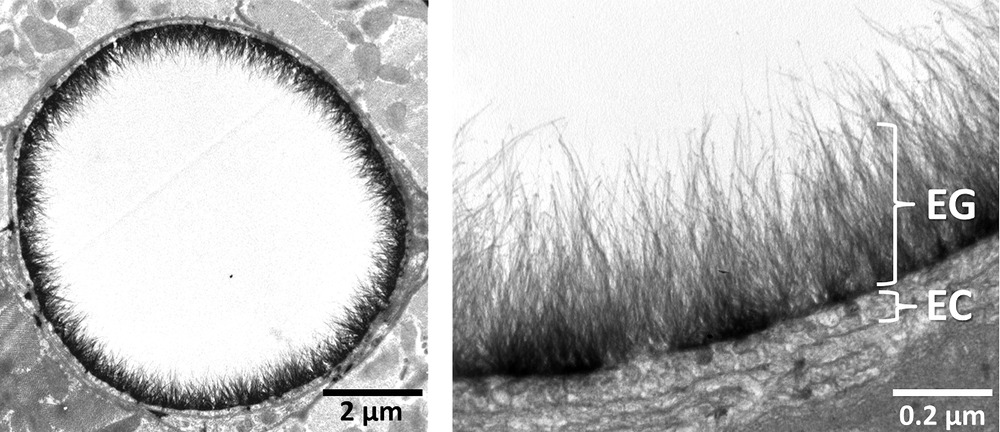Image from: Haeren, Roel; van de Ven, Steffi; Vink, Hans et al. Assessment and Imaging of the Cerebrovascular Glycocalyx. Current Neurovascular Research. 13(3). Published May 2016. DOI 10.2174/1567202613666160504104434
The endothelial glycocalyx (eGCx) has received greater research attention over the past few years. When it was first visualized in the 1960s, thanks to the invention of the electron microscope, it proved that blood vessels were not simply hollow tubes, as was previously thought. We now know that the glycocalyx is a complex of proteoglycans and glycoproteins anchored into the endothelial cell membrane. It also has branching extensions with a gel-like coating that project into the lumen of the blood vessel. 1
Glycocalyx Structure and Function
The eGCx is a protective barrier on the luminal surface of all blood vessels that serves many functions. The tertiary branching of hyaluronan creates a selectively permeable interface allowing only small molecules, like water, electrolytes and nutrients, to pass through the endothelium.2 The strong negative charge of the glycoprotein and proteoglycan extensions repels larger molecules, like albumin and cholesterol, and prevents them from penetrating the endothelium.1
The outermost extensions have an anticoagulant effect by preventing red blood cells and platelets from attaching to the endothelium.3 White blood cell adhesion is also selectively permitted with an intact eGCx.2 The extensions house superoxide dismutase to neutralize free radicals and reactive oxygen species. Lastly, the shear stress, which is the pressure exerted onto the extensions by blood pressure, stimulates nitric oxide synthesis, thereby regulating vasodilation and the blood flow rate and pressure through the vessel.1
Glycocalyx Damage and Cardiovascular Consequences
With so many functions for vascular health, it probably comes as no surprise that a compromised eGCx can have serious health consequences. In fact, “endothelial glycocalyx deterioration is considered an early step in the onset of basically all chronic vascular complications.”2
The breakdown of the eGCx allows cholesterol to enter the endothelium and start the plaquing process. Only through a compromised glycocalyx can atherosclerosis occur! Damage to the glycocalyx results in increased vascular permeability, which can be thought of in simple terms as “leaky vessels.” The increased vascular permeability also causes vascular edema in the local environment of eGCx damage.4
With the anticoagulant activity of the eGCx impaired, an overactive coagulation process occurs.2 The synthesis of nitric oxide and superoxide dismutase is also impaired, which increases oxidative stress and vasoconstriction.4
Furthermore, damage to the eGCx releases fragments of glycoproteins and proteoglycans. This activates immune cell migration to the site because the fragments are considered “foreign,” leading to localized inflammation and the expression of ICAM and VCAM-1.2
Diseases That Contribute to Glycocalyx Damage
Many diseases, processes and variables contribute to eGCx damage. The list below is probably incomplete as further research will likely reveal more variables. Here are the currently known causes of eGCx damage:
- Systemic and local inflammation
- Diabetes mellitus
- Chronic and acute kidney disease
- Stroke
- Cancer
- Sepsis
- Ischemia-reperfusion
- Atherosclerosis
- High blood pressure
- Viral infections4
- Traumatic brain injury2
- Trauma
- Excess sodium from aldosterone5
- Hypovolemia6
Measuring Glycocalyx Damage
Measuring damage to the eGCx is challenging as there currently is no commercially available test. At this time, the method that provides the closest assessment of eGCx function is the Glycocheck, a sublingual device that measures microcirculation. Syndecan-1 is the most prevalent and researched component of the eGCx for assessing damage, although it is not yet available commercially.5
Glycocalyx Regeneration
Preserving the health of the eGCx is pivotal to cardiovascular health because worsening endothelial cell barrier dysfunction can lead to plaque rupture and thrombosis.2 The exact science for regenerating the glycocalyx does not exist—how can we validate treatments that cannot be assessed? However, there can be extrapolations based on the components of the glycocalyx.
Supplements for Glycocalyx Support
Glucosamine and chondroitin supplementation was found to lower cardiovascular death risk in multiple studies.7-9 I was personally astonished when I learned that a “joint supplement” decreased cardiovascular death risk. As it turns out, glucosamine is a precursor for the proteoglycans found in the eGCx; this is the proposed reason why glucosamine decreases cardiovascular mortality.
Hyaluronic acid is another promising supplement for eGCx protection and regeneration. While hyaluronan is a small component of the eGCx, it serves many vital functions. Supplemental hyaluronic acid has been shown to restore the eGCx in rodents.10 However, hyaluronic acid alone is likely insufficient as exogenous hyaluronan is unable to incorporate into the eGCx unless another proteoglycan is present.11
Seaweed is also an option for eGCx regeneration. Fucoidan, a component of brown seaweed, is a highly sulfated, fucose-rich polymer.12 Sulfated heparan and chondroitin sulfate comprise the majority of the eGCx.13 Fucoidan has been shown to offer many health benefits, ranging from immune modulation to gut and cardiovascular health. The polyphenol phlorotannin, another component of brown seaweed, and fucoidan are anti-inflammatory and antioxidants. Brown seaweed like Fucus vesiculosus can help to regenerate and protect the eGCx while supporting whole body health.12
The Bottom Line
Consider the glycocalyx as a fundamental component of the body during the treatment of any cardiovascular condition or other condition that has compromised microvascular or macrovascular circulation. This long-forgotten, vital component of all blood vessels could be the missing key to unlock true vascular wellness.

Megan Borreson, ND is the CM Vitals Clinical Brand Manager at Lifestyle Matrix Resource Center. She attended undergraduate school at the University of Wisconsin–Eau Claire and received her Bachelor of Science degree in cell biology and a Bachelor of Arts degree in Spanish with a minor in chemistry. Dr. Borreson then enrolled at National University of Health Sciences where she graduated summa cum laude with a Master of Acupuncture and Doctorate of Naturopathic Medicine.
References
1. Villalba N, Baby S, Yuan SY. The Endothelial Glycocalyx as a Double-Edged Sword in Microvascular Homeostasis and Pathogenesis. Front Cell Dev Biol. 2021;9:711003. Published 2021 Jul 14. doi:10.3389/fcell.2021.711003
2. Dogné S, Flamion B. Endothelial Glycocalyx Impairment in Disease: Focus on Hyaluronan Shedding. Am J Pathol. 2020;190(4):768-780. doi:10.1016/j.ajpath.2019.11.016
3. Davignon J, Ganz P. Role of endothelial dysfunction in atherosclerosis. Circulation. 2004;109(23 Suppl 1):III27-III32. doi:10.1161/01.CIR.0000131515.03336.f8
4. Qu J, Cheng Y, Wu W, Yuan L, Liu X. Glycocalyx Impairment in Vascular Disease: Focus on Inflammation. Front Cell Dev Biol . 2021;9:730621. Published 2021 Sep 13. doi:10.3389/fcell.2021.730621
5. Becker BF, Jacob M, Leipert S, Salmon AH, Chappell D. Degradation of the endothelial glycocalyx in clinical settings: searching for the sheddases. Br J Clin Pharmacol . 2015;80(3):389-402. doi:10.1111/bcp.12629
6. Schött U, Solomon C, Fries D, Bentzer P. The endothelial glycocalyx and its disruption, protection and regeneration: a narrative review. Scand J Trauma Resusc Emerg Med . 2016;24:48. Published 2016 Apr 12. doi:10.1186/s13049-016-0239-y
7. Ma H, Li X, Sun D, et al. Association of habitual glucosamine use with risk of cardiovascular disease: prospective study in UK Biobank. BMJ . 2019;365:l1628. Published 2019 May 14. doi:10.1136/bmj.l1628
8. King DE, Xiang J. Glucosamine/Chondroitin and Mortality in a US NHANES Cohort. J Am Board Fam Med . 2020;33(6):842-847. doi:10.3122/jabfm.2020.06.200110
9. Bell GA, Kantor ED, Lampe JW, Shen DD, White E. Use of glucosamine and chondroitin in relation to mortality. Eur J Epidemiol . 2012;27(8):593-603. doi:10.1007/s10654-012-9714-6
10. Wheeler-Jones CP, Farrar CE, Pitsillides AA. Targeting hyaluronan of the endothelial glycocalyx for therapeutic intervention. Curr Opin Investig Drugs. 2010;11(9):997-1006.
11. Henry CB, Duling BR. Permeation of the luminal capillary glycocalyx is determined by hyaluronan. Am J Physiol . 1999;277(2):H508-H514. doi:10.1152/ajpheart.1999.277.2.H508
12. Fitton H. Maritech Organic Fucoidans the Science. Cambridge, Tansania; Maritech Pty Ltd. 2018.
13. Reitsma S, Slaaf DW, Vink H, van Zandvoort MA, oude Egbrink MG. The endothelial glycocalyx: composition, functions, and visualization. Pflugers Arch . 2007;454(3):345-359. doi:10.1007/s00424-007-0212-8



